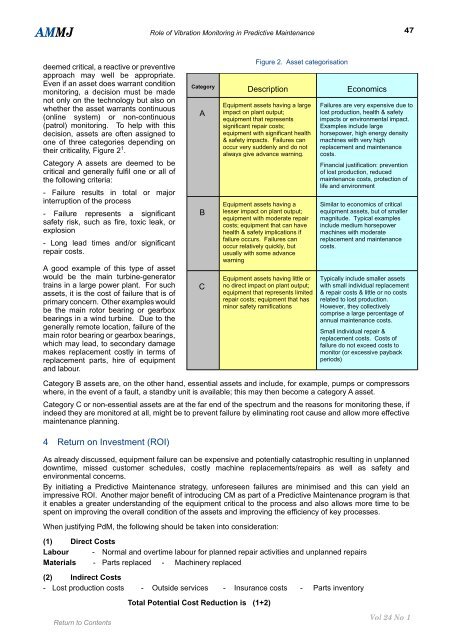AMMJ - Library
AMMJ - Library
AMMJ - Library
Create successful ePaper yourself
Turn your PDF publications into a flip-book with our unique Google optimized e-Paper software.
<strong>AMMJ</strong><br />
deemed critical, a reactive or preventive<br />
approach may well be appropriate.<br />
Even if an asset does warrant condition<br />
monitoring, a decision must be made<br />
not only on the technology but also on<br />
whether the asset warrants continuous<br />
(online system) or non-continuous<br />
(patrol) monitoring. To help with this<br />
decision, assets are often assigned to<br />
one of three categories depending on<br />
their criticality, Figure 2 1 .<br />
Category A assets are deemed to be<br />
critical and generally fulfil one or all of<br />
the following criteria:<br />
- Failure results in total or major<br />
interruption of the process<br />
- Failure represents a significant<br />
safety risk, such as fire, toxic leak, or<br />
explosion<br />
- Long lead times and/or significant<br />
repair costs.<br />
A good example of this type of asset<br />
would be the main turbine-generator<br />
trains in a large power plant. For such<br />
assets, it is the cost of failure that is of<br />
primary concern. Other examples would<br />
be the main rotor bearing or gearbox<br />
bearings in a wind turbine. Due to the<br />
generally remote location, failure of the<br />
main rotor bearing or gearbox bearings,<br />
which may lead, to secondary damage<br />
makes replacement costly in terms of<br />
replacement parts, hire of equipment<br />
and labour.<br />
Category B assets are, on the other hand, essential assets and include, for example, pumps or compressors<br />
where, in the event of a fault, a standby unit is available; this may then become a category A asset.<br />
Category C or non-essential assets are at the far end of the spectrum and the reasons for monitoring these, if<br />
indeed they are monitored at all, might be to prevent failure by eliminating root cause and allow more effective<br />
maintenance planning.<br />
4 Return on Investment (ROI)<br />
Role of Vibration Monitoring in Predictive Maintenance<br />
Category<br />
As already discussed, equipment failure can be expensive and potentially catastrophic resulting in unplanned<br />
downtime, missed customer schedules, costly machine replacements/repairs as well as safety and<br />
environmental concerns.<br />
By initiating a Predictive Maintenance strategy, unforeseen failures are minimised and this can yield an<br />
impressive ROI. Another major benefit of introducing CM as part of a Predictive Maintenance program is that<br />
it enables a greater understanding of the equipment critical to the process and also allows more time to be<br />
spent on improving the overall condition of the assets and improving the efficiency of key processes.<br />
When justifying PdM, the following should be taken into consideration:<br />
(1) Direct Costs<br />
Labour - Normal and overtime labour for planned repair activities and unplanned repairs<br />
Materials - Parts replaced - Machinery replaced<br />
(2) Indirect Costs<br />
- Lost production costs - Outside services - Insurance costs - Parts inventory<br />
Total Potential Cost Reduction is (1+2)<br />
A<br />
B<br />
C<br />
Figure 2. Asset categorisation<br />
Description Economics<br />
Equipment assets having a large<br />
impact on plant output;<br />
equipment that represents<br />
significant repair costs;<br />
equipment with significant health<br />
& safety impacts. Failures can<br />
occur very suddenly and do not<br />
always give advance warning.<br />
Equipment assets having a<br />
lesser impact on plant output;<br />
equipment with moderate repair<br />
costs; equipment that can have<br />
health & safety implications if<br />
failure occurs. Failures can<br />
occur relatively quickly, but<br />
usually with some advance<br />
warning<br />
Equipment assets having little or<br />
no direct impact on plant output;<br />
equipment that represents limited<br />
repair costs; equipment that has<br />
minor safety ramifications<br />
Failures are very expensive due to<br />
lost production, health & safety<br />
impacts or environmental impact.<br />
Examples include large<br />
horsepower, high energy density<br />
machines with very high<br />
replacement and maintenance<br />
costs.<br />
Financial justification: prevention<br />
of lost production, reduced<br />
maintenance costs, protection of<br />
life and environment<br />
Similar to economics of critical<br />
equipment assets, but of smaller<br />
magnitude. Typical examples<br />
include medium horsepower<br />
machines with moderate<br />
replacement and maintenance<br />
costs.<br />
47<br />
Typically include smaller assets<br />
with small individual replacement<br />
& repair costs & little or no costs<br />
related to lost production.<br />
However, they collectively<br />
comprise a large percentage of<br />
annual maintenance costs.<br />
Small individual repair &<br />
replacement costs. Costs of<br />
failure do not exceed costs to<br />
monitor (or excessive payback<br />
periods)<br />
Vol 24 No 1

















